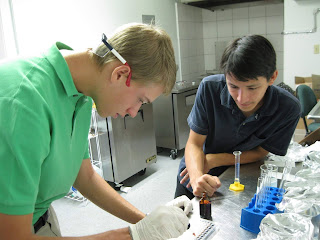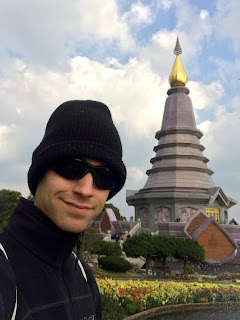 |
| Out for a walk at Stearman Field |
Next was the inflight scenario. Herb gave me a bit more time to get used to this one. He began by slowing pulling the one throttle to idle while we were in cruise flight, allowing me to work out the control pressures needed to keep the plane flying straight. He had me fly along for some time in this manner, letting me experiment with turns and pointing out the anemic 50-foot-per-minute climb rate that we were just managing to maintain at Vyse speed. After I’d had some practice flying around with first the left, and then the right engine idling, it was time to do get some first-hand practice actually shutting down and feathering one engine, as one would have to do if the engine was malfunctioning. It was definitely a strange feeling to look out and see the propeller sitting motionless, a state that you usually only see when the plane is on the ground and parked. But that’s what this training is all about—learning that it’s quite possible and safe to keep flying the plane on one engine as long as you do it right and follow your training.
Herb walked me through the restart procedure and then it was time to go into the engine failure drills where I would learn how to react if an engine failed in a time- and altitude-critical phase of flight like shortly after takeoff. He gave a quick demo of the five-step procedure that he wanted me to do in order, and then gave me control and proceeded to cut an engine. The plane shuddered slightly and began yawing and rolling to the side. “Okay, fly the plane,” I mumbled, pushing in rudder and aileron to try to keep it flying straight. I suddenly realized that what all those training articles had said was right—I really had no idea which engine was out. But that’s what the procedure was for. With Herb’s prompting I labored my way through the steps, calling the number of each step out loud as I performed it.
“One…two…three…” Engine levers set for maximum power. “Four…five”. Flaps and gear up.
“Now identify the failed engine,” Herb commanded. I still didn’t quite know which one it was, but the next step in the procedure would fix that problem. I looked down at my legs. My left foot was pressing hard against the rudder pedal and the right foot was on the floor doing nothing. I slapped my right thigh and then pointed at the engine on that side. “That one is dead.”
“Okay, verify.” I pulled back the throttle on the right engine—if I had identified the wrong engine, there would be a noticeable loss of power and a corresponding yaw. There was no change. “Feather it.” I went through the motion of starting to feather the propeller to place it in a minimum drag position and Herb followed up by resetting the engine controls to give “zero-thrust”, which is a slight amount of power to simulate the feathered condition.
“Good. I’m giving you the engine back. Watch the rudder,” I heard Herb say, signaling the end of the exercise. I eased off the left pedal as the power on the right engine was restored. I relaxed my iron grip on the yoke and took a breath. “Alright, let’s do it again,” he said.
My legs felt like jelly by the end of the flight, following engine-out after engine-out. It was an empowering feeling, though, getting to see the time-tested procedure in action and programming the correct response into my muscle memory. I saw first-hand how easy it is to get things wrong unless you do the procedure methodically without skipping steps, like when I correctly identified the failed engine and then started to reach for the wrong throttle during the “Verify” step before I corrected myself and grabbed the correct lever. The procedure would have caught the mistake, but being careful to avoid rushing will prevent the majority of mistakes from happening in the first place. The last thing you want is to kill the good engine—it’s been done before.
 |
| Coming in after an evening "hop" |
With the intro at altitude completed, it was time to fly engine-out instrument approaches. Again, it turned out to be more manageable than I expected. The main difference was in having to remind myself that I was essentially committed to land once on final approach, because the typical light twin doesn't have the capability to fly a missed approach on one engine.
My legs held out for the flight—just barely. I was ready for a good, long rest by the time we made it back to Stearman Field. After we shut down, Herb informed me we had now gone through all the maneuvers that were required for the checkride. Tomorrow we would practice them up to standards, Friday morning we would fly to get warmed up and work out any bugs, and then I’d take my checkride. Whew!
 |
| Prairie Air Service - a great home away from home |
And so by this point in the week the days had already taken on a familiar rhythm: wake up, eat breakfast while I read from my Bible, and then have the first lesson at 9:30 or more often 10:00. The afternoons were free for studying and then after dinner at 5:00 we would go up for a second flight. Then I usually went for a long walk on the airport property, and if the temperature was mild when I got back I would join Herb and his wife Kathy on their patio to sit and chat late into the evening. Though I could expect an intense workout with high expectations from Herb while in the plane, all that stayed in the cockpit and the rest of the day was just stress-free. It was lovely.
I went to bed Thursday evening realizing this was so different from any other checkride I’d had to date. No need to wake up before dawn to get ready. No need to do a long drive or fly myself to the test. And the fact that I still had one more training flight before the test itself somehow made it seem like just another event in the next day’s schedule. I slept soundly, with none of those exhausting I’m-running-behind! dreams to bother me.
Friday was another day of unusually calm air. I’d enjoyed the good fortune of being able to fly in very stable air this whole week—something not normal for Kansas at this time of year. Apparently, high altitude smoke layers from West Coast fires were messing with the weather pattern.
Herb had me run through each maneuver, demanding precision and promptness. I did my best, making a few mistakes here and there, but in general I felt it was a decent performance. It was certainly nice to be already warmed up for the afternoon’s flight—and this was one of Herb's secrets to having a high pass rate.
But I was rather tired too! During the week I had made it a habit to chair-fly every time I came back from a lesson, reviewing mistakes and mentally rehearsing procedures to get the steps down smoothly, but today I felt that trying to do more mental practice was going to be counterproductive. Just take it easy. There’s no need to cram anything else; you’re ready, I convinced myself. So I went a took a nap. I felt great after that.
As 3:00 p.m. approached, I heard a vehicle approaching. Peeking out my window blinds, I saw the car pulling into the driveway. Yup, that was him. It’s showtime.
The checkride went as smoothly as I could hope for it to go. Herb had done his job well; the actual test itself was easier than flying with Herb. Granted, I made a few mistakes here and there—no checkride is error-free—but as the examiner continued to tick off boxes on his checklist and direct me to do the next maneuver, I grew more and more confident. The end was coming within sight.
“Okay, give me a normal takeoff from here and a normal landing back in Benton and we’ll call it a day. Sound good?” I nodded happily. I had finished all the “hard” stuff and all that remained was to make it back to the home airport without doing anything dumb. I stopped the plane in front of the hold-short lines at Newton airport to take a moment to set up the avionics for the leg back. I started to flip AWOS and CTAF radio frequencies for my destination airport into the number one radio when I realized what I was doing. “Oops,” I said sheepishly, restoring Newton’s traffic advisory into the active frequency. “Getting too far ahead of myself.” It was the last silly thing I did on the flight. The rest went off like clockwork, and as we pulled off the runway back at Stearman Field, I couldn’t keep myself from thinking, Michael, I think you made it...!
 |
| One of my favorite kinds of handshakes |
My examiner was relaxed and nonchalant, as only people who do this job day in and day out can be. As I shut down the engine, he wrote down the Hobbs reading and then asked, “So you’re planning to do the multiengine instructor rating as well?” I nodded. “It’s the easiest of the three instructor rides. You’ll have no problem.”
A few minutes later my old plastic pilot certificate had a hole punch in it and I was holding a piece of paper with the words Temporary Airman Certificate at the top.
One checkride down. One to go.




















